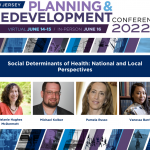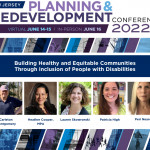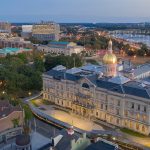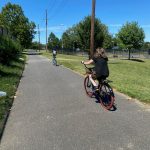New Jersey Future Blog
Access to Parks is an Environmental Justice Issue
April 19th, 2023 by Hannah Reynolds
Conversations around environmental justice (EJ) and social determinants of health are commonly focused on the inequities that are present in underserved communities: the dangerous developments and contaminants. Often, the focus of environmental justice efforts is on remediating the lead and forever chemicals like PFAS found in the drinking water of low-income communities, or cleaning up the massive superfund sites or improving air quality near freeways that are often sited in communities of color. So naturally, there is a limited discourse in the environmental justice movement on what is missing in communities that have been historically marginalized, especially when it comes to things taken for granted as amenity, like parks.
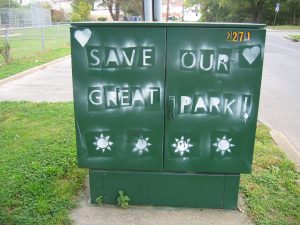
Camden, New Jersey
“To provide an overarching perspective, there are 100 million people in the United States—of which 28 million are children—who don’t have access to a park within a ten-minute walk of their homes. That’s an equity statement,” said Scott Dvorak, the Associate Vice President and New Jersey State Director of the Trust for Public Land. “In communities of color, the parks people do have access to are, on average, half the size and serve five times as many people as those in privileged areas. In these parks, the programming needs and demand are higher, but the entities responsible for maintaining the parks often have restricted resources.”
Nearly a third of Americans do not have easy access to parks, making access to parks and public space a luxury in our country. However, the data shows striking disparities in park access for people in underserved communities and from marginalized backgrounds. An estimated 76% of people living in low-income communities of color live in places deprived of nature, with communities of color experiencing roughly triple the rate of nature deprivation compared with predominantly white communities. Consequently, people living in low-income, majority-minority communities disproportionately experience firsthand the impacts of the destruction of nature related to air and water pollution, waning biodiversity and the spread of diseases, and the impacts of climate change, to name a few. In New Jersey, Governor Phil Murphy has moved to cut admission fees to state parks, with the state charging no state park fees in 2022 and seeking to do the same in summer 2023. By reducing cost barriers to visiting parks, New Jersey has taken great strides toward creating more accessible parks for all New Jerseyans to enjoy. But why is access to parks so important for promoting environmental justice?
The accessibility, availability, and funding of parks plays a crucial role in health outcomes. One major function of parks for health is to foster access to open space for exercise and physical activity. The Centers for Disease Control and Prevention recommends that young people get at least an hour of physical activity per day and that adults do at least an hour and a half of aerobic activity each week to stay healthy. However, the majority of Americans do not get enough exercise, with only 25% of adults meeting these recommendations and with nearly a third of American adults engaging in no exercise in their leisure time.
Lack of physical activity is associated with a number of physical health concerns including obesity, high blood pressure, high blood cholesterol, heart failure, stroke, osteoarthritis, reproductive and bladder issues, and pregnancy complications, as well as many mental health concerns like depression, eating disorders, and low self-esteem. Overall, the trends of insufficient exercise and physical health concerns within the population hold serious ramifications for the wellbeing of Americans.
However, access to parks offers opportunities for health outcomes to be improved, with the availability and accessibility of green outdoor spaces for recreation acting as social determinants of health. When Americans obtain increased access to parks and advertisements about park offerings, events, and amenities, studies show that exercise can increase in frequency by nearly 50%. At the same time, energy levels, weight loss, and flexibility generally improve with heightened access to a place for exercise. Further, mental health is significantly associated with access to parks and nature, with reports of heightened attention, mood, and cognitive functioning, as well as reduced stress.
Beyond this, the benefits of accessible parks extend to community health, with social cohesion and economic outcomes—such as lowered healthcare spending and heightened financial security—are also found to be correlated with park accessibility. In other words, reliable access to parks and open outdoor spaces promotes exercise and consequently boost health outcomes in an otherwise too-sedentary population. Therefore, park equity can and should be considered a matter of environmental justice just as much as contaminated water or toxic construction sites.
Beyond supporting health outcomes, green spaces can benefit the natural environment, curbing urban heat island effects, supporting stormwater management naturally, and enhancing air quality. Reduced air pollution related to parks can lower rates of asthma, which disproportionately impacts people of color, and has been found to be associated with the spread and mortality of COVID-19. Altogether, it becomes clear that low-income areas with high sprawl development—where the expectation of driving limits access to parks and green spaces for low-income people—can negatively impact health outcomes, posing a serious inequity for marginalized and underserved populations—which begs the question, why aren’t we investing more in parks?
Beyond mere access to green space, equity issues around parks extend to quality and upkeep of these public spaces, as well as the safety of walking or biking to a given park. While two-thirds of Americans have access to parks within a 10-minute walk, according to Scott Dvorak, there remains vast disparities around quality, size, demand, and maintenance of parks. Many parks situated within low-income communities of color are often poorly maintained, dangerous, understaffed, or underfunded. Investing in existing parks to create safe, clean, resilient parks for all to enjoy will meet the demands of the communities they serve. Not only that, but maintenance of green spaces saves money. One study reports that for every one dollar spent on creating and maintaining park trails, three dollars of healthcare spending can be saved.
However, the ability to walk to a park within a ten-minute radius does not guarantee that the infrastructure and streets to get there are safe, clean, or even present. Especially in low-income communities, there may not even be sidewalks connecting local people to such parks. Therefore, if a park is only truly accessible by driving, this will limit who can enjoy a park, preventing many low-income people from spending time at the park. Though New Jersey ranks second in the country for most land dedicated to park spaces, as the nation’s most densely-populated state, urban sprawl, disinvestment in urban areas that largely consist of people of color and people with lower socioeconomic status, lack of connectivity, and poor planning all have contributed to determining which New Jerseyans have easy and safe access to parks, which is certainly not equitable or inclusive for all. Through all of this, it is clear that equity around park access is dependent upon not only the presence of parks, but also their quality.
“Accessibility is not only, of course, about race and income. It’s also about ability, age, special needs, and making parks accessible for the whole spectrum of human condition.” Scott Dvorak of the Trust for Public Lands put it well. It is crucial to not only advocate for increased availability of parks, but also to ensure that parks have proper funding, maintenance, staffing, and connectivity with the community, in order for local peoples to enjoy all the benefits of public spaces and parks. At present, too many Americans lack access to nearby parks and the environmental and health benefits they offer, demonstrating that park access can act as a predictor of health outcomes. Ultimately, if we are to achieve an environmentally-just world, equitable and reliable access to parks and open spaces for all people is an essential step.
Related Posts
Tags: accessibility, community, environmental justice, equity, green space, health, Open Space, park, parks, sprawl

